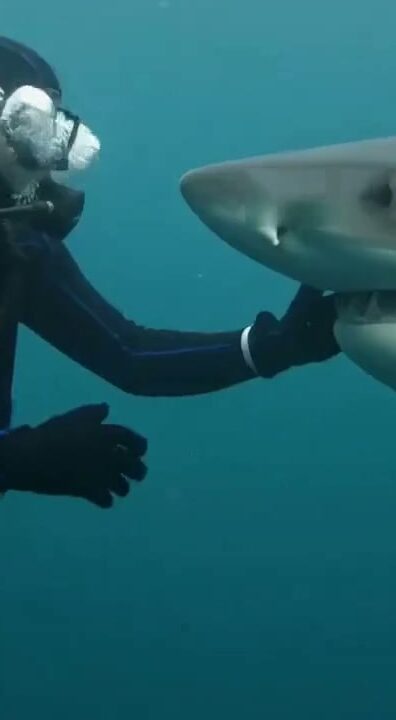
It began as a perfect day for Liam Carter, an experienced diver who had spent years exploring the ocean’s depths. The sea was his second home — calm, vibrant, and endlessly captivating. He had always believed that respect and trust could bridge the gap between humans and nature.
That morning, off the coast of South Africa, the water was glassy and clear. Liam was diving as part of a conservation project, documenting marine life. His focus was a great white shark he’d been observing for weeks.
The massive, graceful shark had grown accustomed to his presence, often circling nearby with slow, deliberate movements. Over time, Liam began to think the creature recognized him — that they shared a unique understanding.
His fellow divers cautioned him. “They’re wild, Liam,” one warned. “No matter how calm they seem, never forget what they really are.” Liam just smiled. “She’s different,” he said. “Gentle.”
For thirty minutes, everything went smoothly. The shark glided through the water, majestic and serene. Liam floated beside her, filming every move. He reached out his hand — a gesture of trust he had made before.
Then, in an instant, everything changed. The shark turned sharply, eyes darkening, and lunged before Liam could react. The ocean he’d loved became a battleground. The shark’s jaws clamped onto his arm with terrifying force.
His scream was swallowed by the water. His camera slipped from his grasp, spiraling into the depths as blood clouded his vision. Instinct kicked in — he kicked, twisted, and punched, desperate to break free. Pain, fear, and survival consumed him.
For a moment, he thought it was over. The shark released him but circled back, brushing close as if testing him. His oxygen was running low. His arm was torn, agony radiating through his body. Panic clawed at him.
Yet, something inside refused to surrender. Using his remaining strength, he pushed toward the surface, fighting to stay conscious. Above, the sun shimmered — so near, yet unreachable.
The rescue team had seen the struggle from the boat and dove in, pulling him out just before he blacked out. The ocean that once embraced him now felt merciless — beautiful, yes, but unforgiving.
In the hospital, wrapped in bandages and weak from blood loss, doctors told him he was lucky to be alive. Most don’t survive attacks like his. Liam barely believed it himself.
Reporters called him “the man who trusted the wrong shark.” His footage went viral, shocking millions. Some called him reckless; others praised his bravery. But Liam didn’t care about the opinions.
“I don’t blame the shark,” he later said. “It wasn’t evil — it was instinct. I forgot that even nature’s most beautiful parts can be dangerous.” His words struck a chord, serving as a caution about respect and humility.
Months passed, and while his body healed, the scars remained — visible and invisible. Yet Liam found the strength to return to the ocean, where his soul felt at home.
He no longer swam close or reached out. Instead, he watched from a respectful distance, reminding others that nature demands balance, not control. Trust must be earned, not assumed.
The shark was later spotted again — healthy and ruling her territory. Liam smiled at the footage. “She survived too,” he said quietly. “We both did.”
His story became one of survival and wisdom — proof that courage isn’t just facing danger, but learning from it. Liam’s mistake nearly cost him his life, but it also gave him rare insight.
Now, every dive carries the memory of that day — an invisible scar and a quiet lesson that the wild owes us no gentleness, but always deserves our respect.
Though marked by that encounter, Liam wouldn’t change a thing. “She reminded me,” he says, “that respect is the truest way to live with nature.”